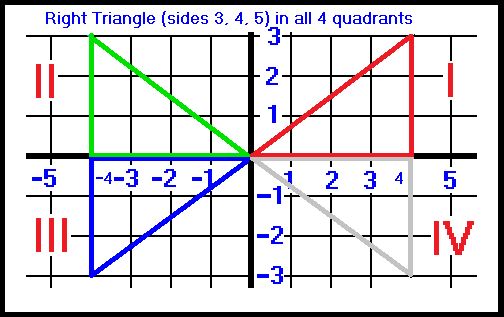 Here, we have drawn a right triangle (with sides 3, 4 and 5) in each of the 4 quadrants.
Here, we have drawn a right triangle (with sides 3, 4 and 5) in each of the 4 quadrants.
Since all 6 trigonometric functions are positive in the first quadrant , let's look at the green triangle in quadrant II.
How can we tell if the sine function is postive or negative in the second quadrant?
• The sine function equals the opposite side (y-value) divided by the hypotenuse. As we can see the y-value is positive and so the sine value is positive.
• The cosine function equals the adjacent side (x-value) divided by the hypotenuse. The adjacent side is negative and therefore the cosine value is negative.
• The tangent function equals the opposite side (y-value) divided by the adjacent side (x-value). Even though the opposite side is positive, the adjacent side is negative and therefore the tangent value is negative.
• cotangent function = adjacent side (x-value) ÷ opposite side (y-value).
adjacent side is negative, therefore cotangent is negative.
• secant function = hypotenuse ÷ adjacent side (x-value).
adjacent side is negative, therefore secant is negative.
• cosecant function = hypotenuse ÷ opposite side (y-value).
opposite side (y-value) is positive therefore cosecant is positive.
You can easily determine these for the other quadrants.
|
| |